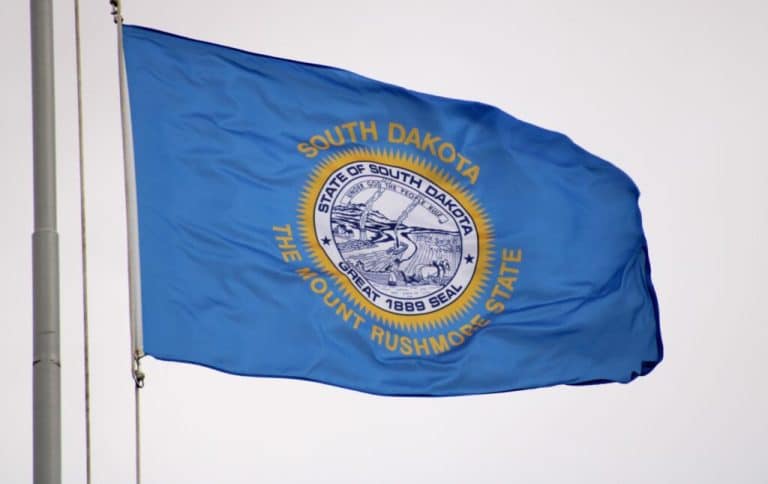RAPID CITY, SD – Anglers and water users are criticizing a Black Hills dam’s government managers for a lack of communication about sudden low-water flows threatening downstream fish and domestic water supplies.
Rapid Creek flows dropped from 40 to 12 cubic feet per second on Nov. 30. That imperiled brown trout spawning, which occurs during the fall, and created a water pumping problem for some who rely on the creek as a water source.
The cause of the drop in flow was the closure of a dam gate at the Pactola Reservoir, which allows water to flow into Rapid Creek below the dam. The creek flows east out of the Black Hills through Rapid City to the Cheyenne River.
Pactola is the largest and deepest reservoir in the Black Hills. The dam was constructed in 1952 and is managed by the U.S. Bureau of Reclamation. The bureau maintains and controls releases in conjunction with the city of Rapid City.
Pactola feeds the bureau’s Rapid Valley Unit, which provides multiple benefits, including irrigation for about 8,900 acres of farmland, water for municipal and industrial users in Rapid City and at Ellsworth Air Force Base, and flood control.
Problem discovered
Crystal Lesmeister, a civil engineer in Rapid City with the bureau, said a dam gate was closed after a routine inspection revealed the need for a repair at the dam.
“We needed to do some repair work on the gate, and in order to do that work, we switched to a bypass pipe,” Lesmeister said.
The bypass pipe resulted in lower creek flows, because the pipe allows less water to pass through than the dam gate.
Evaporated liquid was building up to the point of cracking part of the dam’s gate system. The problem was identified during an inspection in November. Repair work began on Nov. 28, and the bypass pipe was opened to allow continued flows while repairs were being made.
“Reclamation, in coordination with the city, began repairs to concrete infrastructure and to prevent possible damage to the left regulating gate,” Joe Hall, the bureau’s Dakotas area manager, said in a written statement. “After investigation of the cracking, special bonding was ordered to repair these damages.”
The bureau said the repairs are necessary due to the location of the problem and cracking, and waiting longer could lead to more extensive repairs.
Some of the materials needed to complete the repair were not on hand and are now being shipped. Meanwhile, flow rates rose back to over 30 cubic feet Thursday evening.
Water users affected
An association of 197 homeowners draws drinking water from the section of Rapid Creek where flow rates dropped. Hisega Meadows Water manages that water.
Additionally, about 400 people in the unincorporated area on Highway 44 – 10 miles or so downstream of Pactola – individually rely on the creek for water, according to Scott Licht, Hisega Meadows’ water operator.
Licht said pumping water typically costs $27.71 and requires two hours of labor a day. At the lower flow rate, Licht said it costs $129.32 and eight hours of work.
“The danger is it can get to the point where we can’t pump water,” Licht said. “We’ve got just under 500 people who wouldn’t have clean, safe water.”
Brown trout spawning impacted
David Hanna, a Hisega Meadows resident and president of Black Hills Fly Fishers, is worried about the negative effects on fish.
“There are a lot of brown trout eggs between Pactola Reservoir and Canyon Lake that have been exposed to air, and we will lose a large portion of this age class of fish,” Hanna said.
Jake Davis, Game, Fish and Parks fisheries program administrator, said in a written statement, “there is a relationship between trout numbers and stream flow in Rapid Creek and the potential exists for negative impacts to the population as a result of low flows.”
Davis said it’s still too early to tell if a regional fishery will need to release brown trout to get numbers up.
“We still need to determine what the need will or won’t be,” Davis said.
Lack of communication
The Bureau of Reclamation did not communicate with GF&P about the closure.
Crystal Lesmeister with the bureau said if it had waited much longer, there would be too much ice to conduct the repair. And if the bureau had waited until after the winter snow melted, there would be too much water to close the gates.
“We wanted to get repairs done now, ahead of big releases in spring and before the creek freezes over,” Lesmeister said. “And we clearly didn’t communicate that very well. The last time we had to go in and make a repair like this was probably seven or eight years ago.”
Lesmeister said a cost-benefit analysis takes place when these decisions are made.
“We do have operating procedures that we follow,” Lesmeister said. “We do try and balance the needs of everybody on the creek. I do think we could have communicated this better.”
Hans Stephenson, the owner of Dakota Angler & Outfitter in Rapid City, hopes the controversy results in better communication going forward.
“If there had been some advance notice, it would have looked a lot better for the Bureau of Reclamation than it’s looking right now,” Stephenson said.
More at: South Dakota SearchLight













